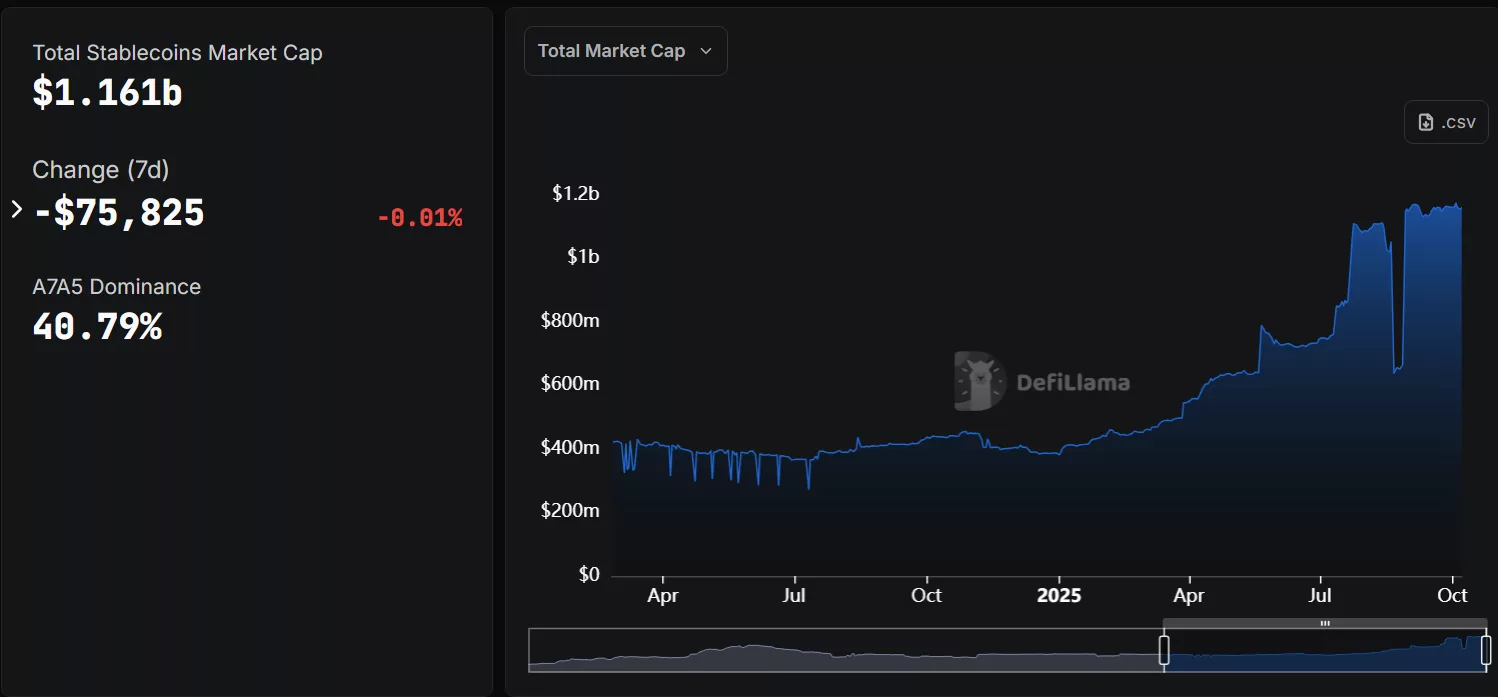Ruble-Backed A7A5 Emerges as the Largest Non-USD Stablecoin
A7A5, a stablecoin backed by the Russian ruble and issued in Kyrgyzstan, has eclipsed EURC to become the largest non-USD pegged stablecoin globally, boasting a market cap nearing $500 million.
Summary
- A7A5 experienced a remarkable 43% rise in a single day, elevating its market cap to $473.58 million and surpassing Circle’s EURC to become the leading non-USD stablecoin in the world.
- The Ruble-backed stablecoin is under scrutiny from Western regulators, with connections to sanctioned banks in Russia and Kyrgyzstan leading the EU to contemplate additional sanctions against the token.
According to DeFi Llama data, the value of the ruble-backed stablecoin skyrocketed by 43% in just one day, raising the token’s market cap by $473.58 million. It swiftly overtook Circle’s euro-pegged EURC, which had a market capitalization of $254 million.
The token’s market cap represents approximately 40.79% of the total stablecoin market capitalization, currently valued at $1.16 billion.
In a Telegram announcement, the stablecoin celebrated achieving the status of the world’s largest non-USD stablecoin. The project anticipates that by 2028, non-dollar stablecoins could comprise 20% of the market as it enhances its token functionalities.
“We have demonstrated that a national digital currency can serve not only as an alternative to the dollar but also as a catalyst for global transformation,” stated the project in a translated Telegram update.
The price surge followed closely after the project participated in Singapore’s Token2049 convention just two days prior.

At the conference, Oleg Ogienko, Director of International Development for A7A5, discussed the project’s offerings, which include solutions that enable users to convert fiat currency to A7A5 and vice versa. Additionally, there are plans to launch Russian domestic debit and credit cards linked to A7A5, allowing foreign users to exchange their currencies for ruble-backed stablecoins.
“We firmly believe that the future belongs to non-dollar stablecoins, and A7A5 is at the forefront of this evolution,” Ogienko asserted during Token2049.
However, the token’s presence at the event raised compliance concerns. Just a day prior to the price increase, reports indicated that the Russian ruble-backed stablecoin had facilitated over $6 billion in cross-border transactions since August 2025, even with some key operators under Western sanctions.
A7A5 Linked to Sanctions
A7A5 is characterized as a token supported by a “diversified portfolio of fiat deposits held in reputable banks within Kyrgyzstan’s framework.” It is issued under Kyrgyzstan’s regulations and claims to be backed at a 1:1 ratio to the Russian ruble.
A7A5 provides its holders with daily passive income, representing half of the interest accrued on its backing deposits. Initially launched on the Ethereum (ETH) and Tron (TRX) blockchains, the token quickly caught attention.
Shortly after its February launch, analysts drew connections between the ruble-backed stablecoin and Grinex, a cryptocurrency exchange perceived as a successor to the sanctioned Russian exchange Garantex. In mid-August, the U.S. Treasury had previously imposed sanctions on Garantex and associated entities, including Promsvyazbank (PSB) of Russia.
As reported by crypto.news, blockchain analytics indicated that over 80% of the total A7A5 supply was destroyed and reissued immediately after new sanctions were imposed on wallets connected to Grinex.
Additionally, the United Kingdom has also enacted sanctions against various banks in Kyrgyzstan, citing the use of A7A5 by Russia to circumvent Western financial restrictions.
Recently, Bloomberg noted that the European Union is contemplating sanctions against A7A5, which would bar EU-based entities and individuals from transacting with the token through third parties.
Several banks from Russia, Belarus, and Central Asia are also embracing this initiative, as they believe that organizations are leveraging A7A5 to navigate around sanctions via cryptocurrency transactions.

